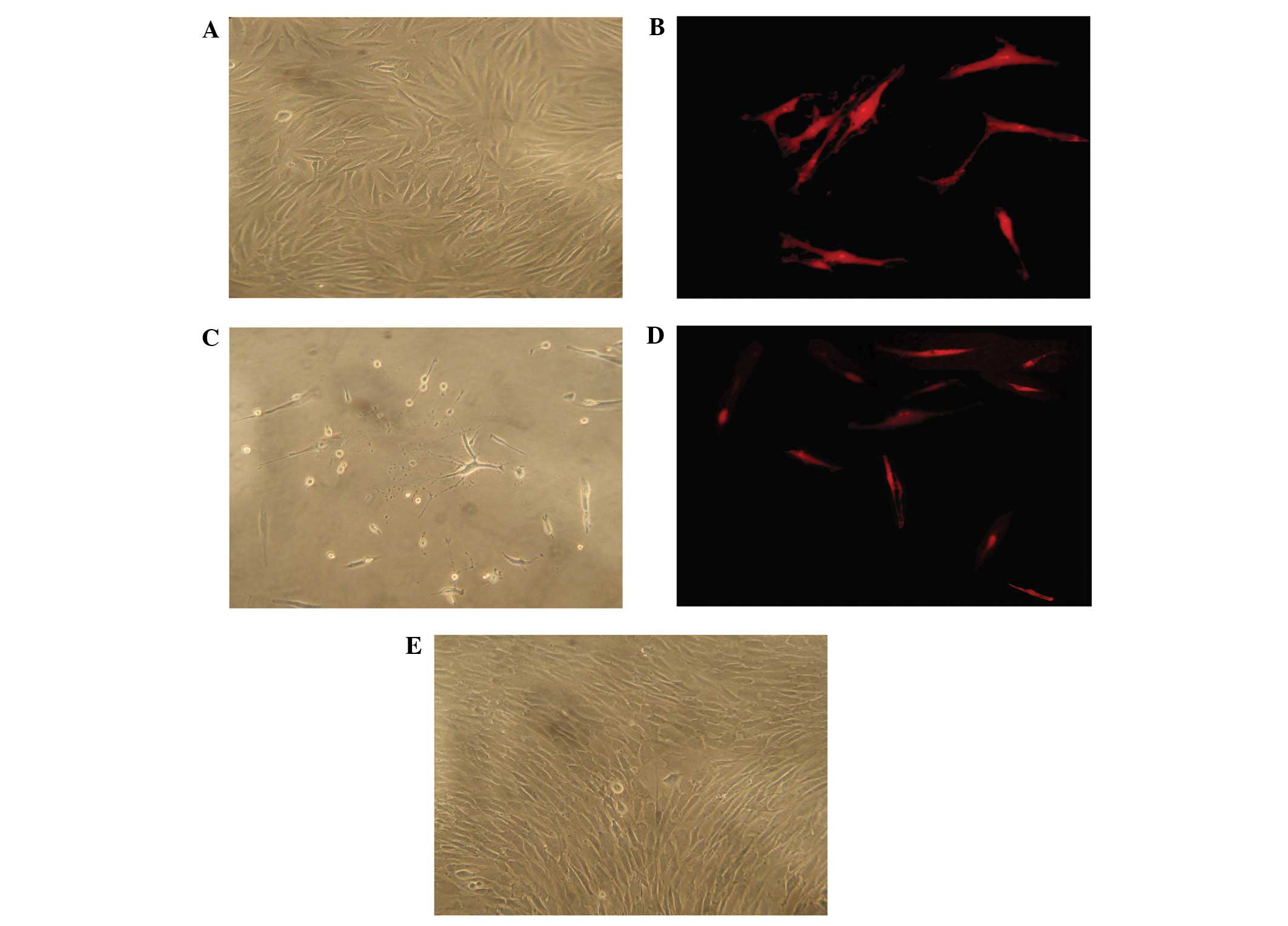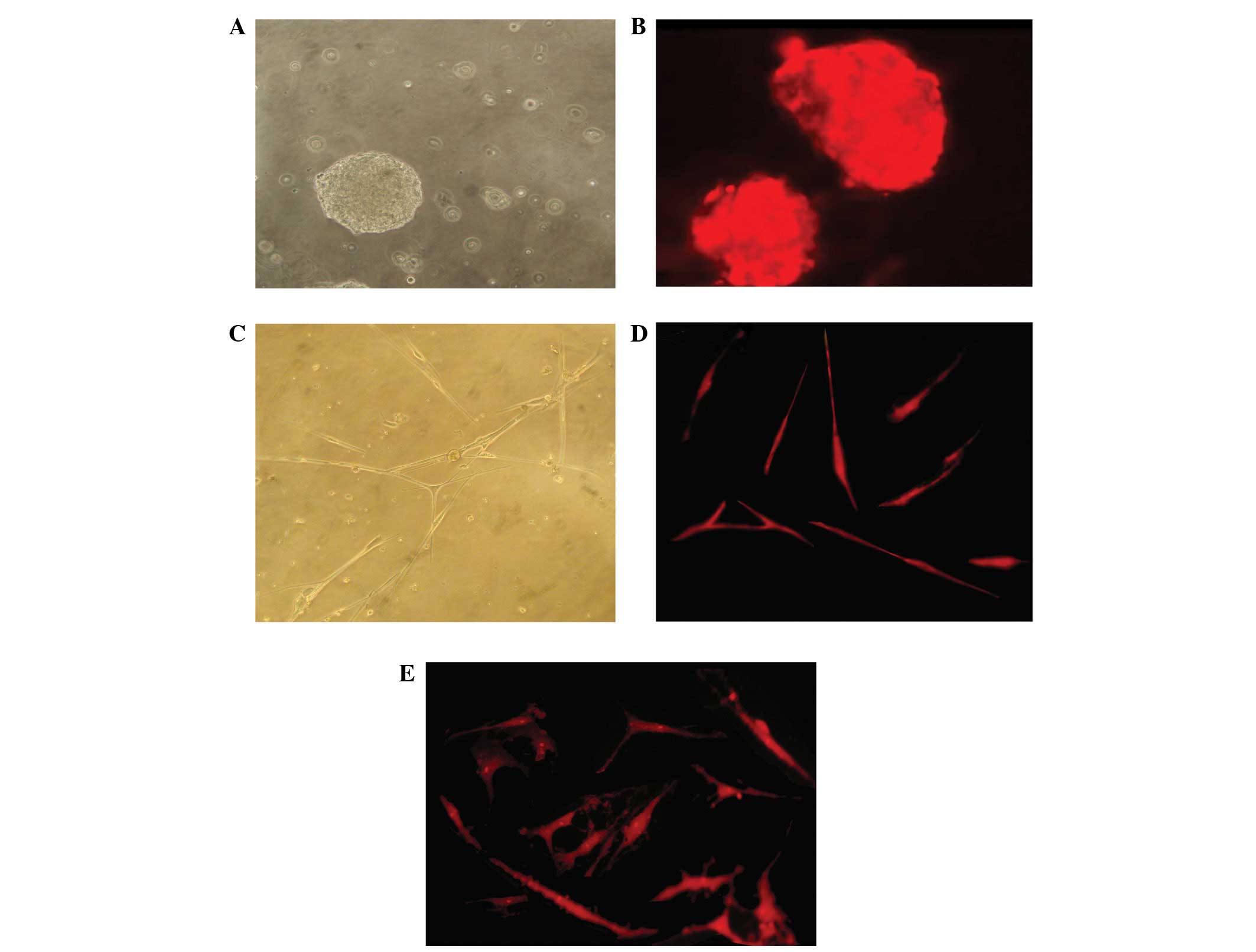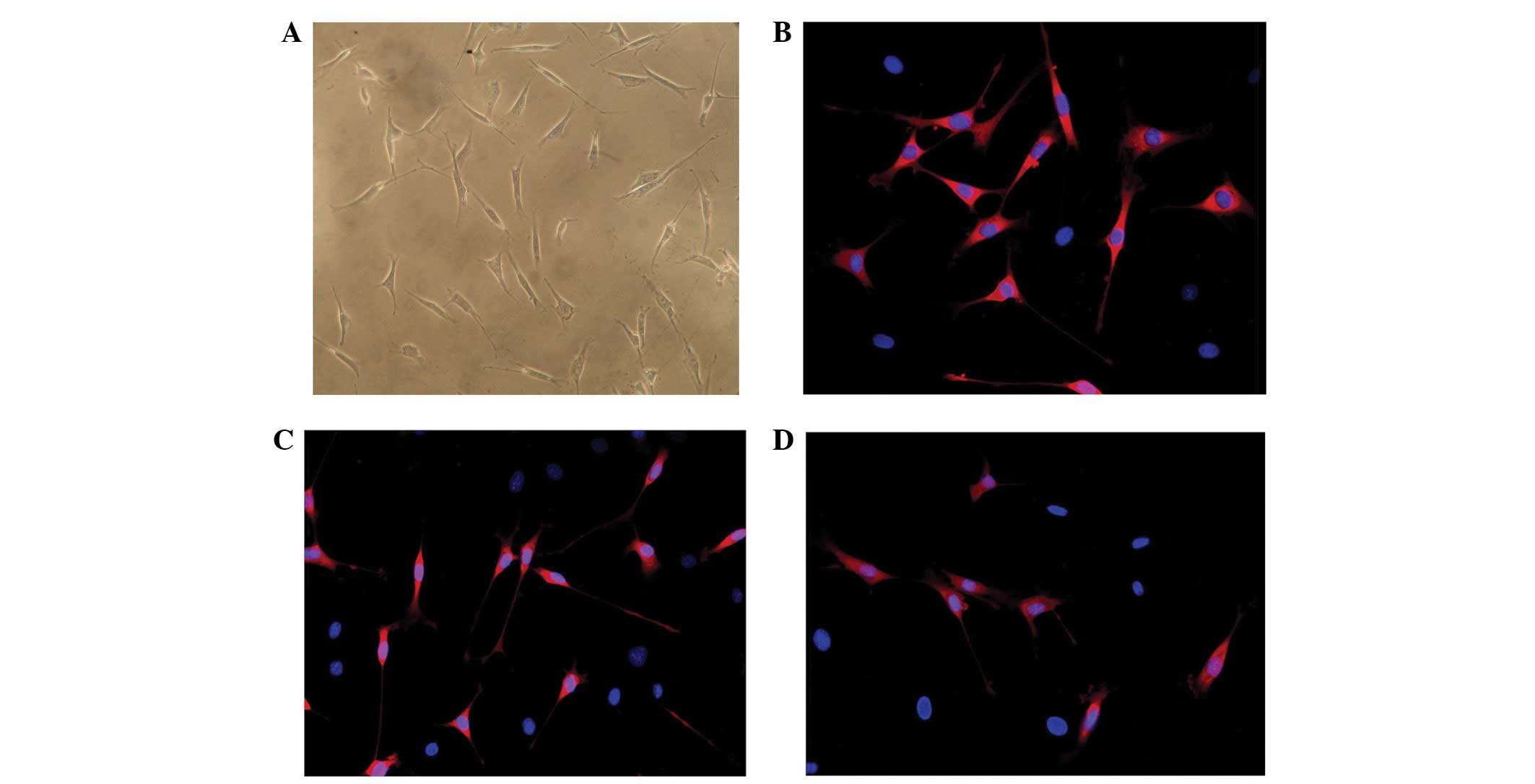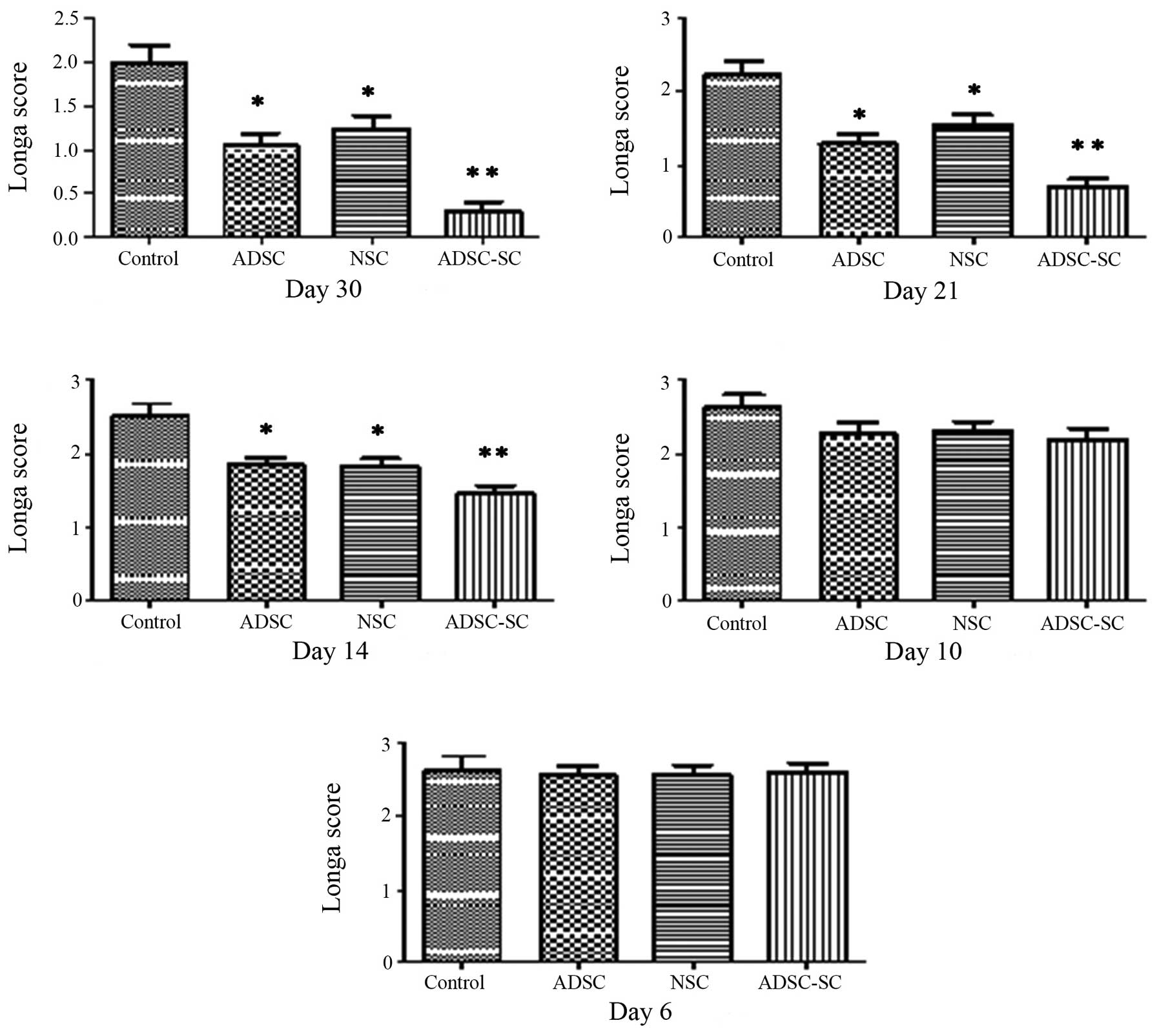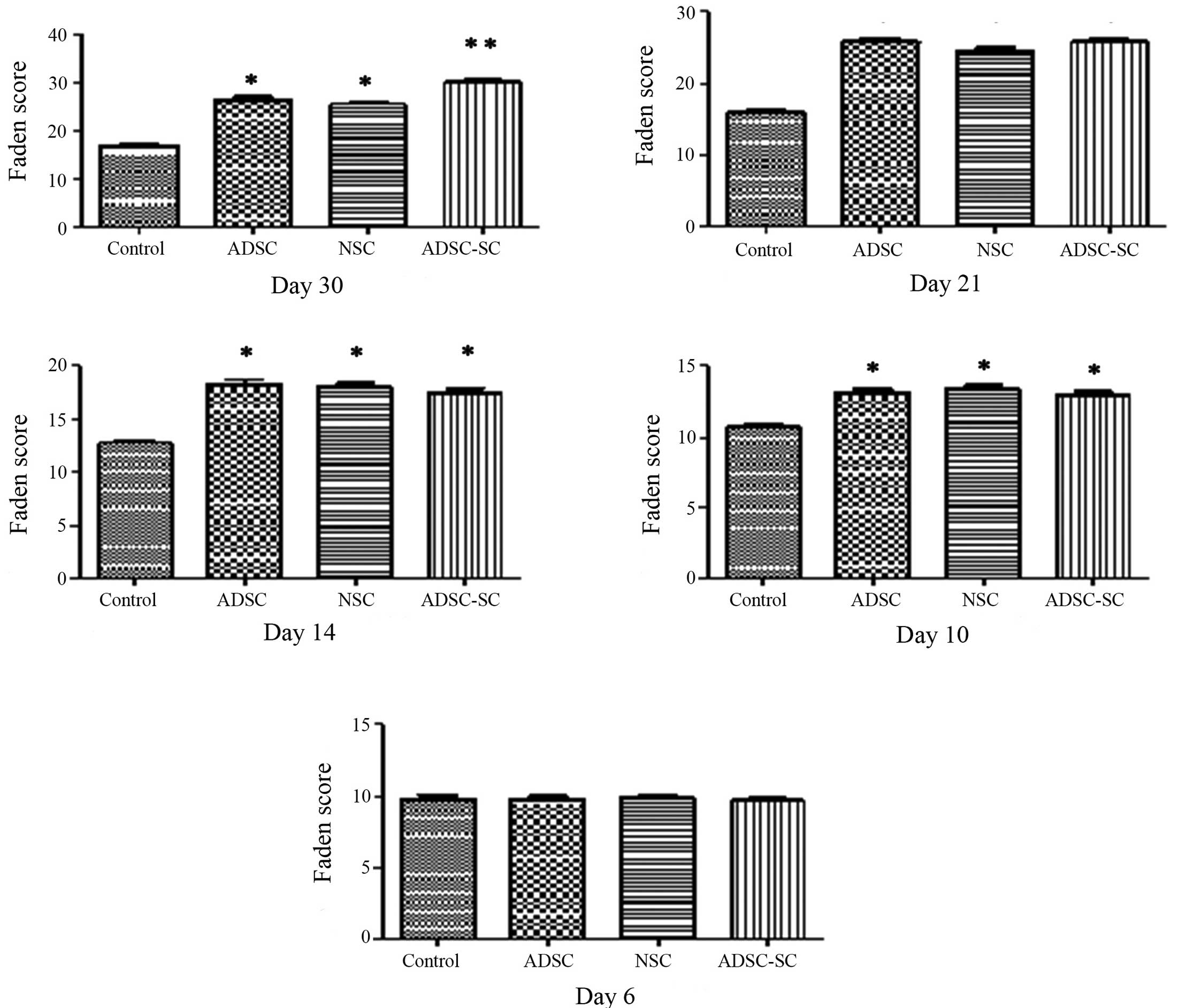Schwann cells differentiated from adipose‑derived stem cells for the treatment of brain contusion
- Authors:
- Published online on: November 25, 2013 https://doi.org/10.3892/mmr.2013.1827
- Pages: 567-573
Abstract
Introduction
Following injury, the central nervous system (CNS) exhibits limited endogenous repair and poor functional recovery. It is known that Schwann cells (SCs) are pivotal in the repair of the peripheral nervous system following injury (1,2). These cells engulf degenerated axons and myelin and form the bands of Büngner and cell bridges to direct regenerating axons across the lesion. They also synthesize and secrete various neurotrophic factors and the extracellular matrix (1,2). However, no similar cells are located in the CNS. Findings of previous studies have demonstrated that the transplantation of exogenous SCs provides trophic support for spared axons and participates in remyelination of the injured spinal cord (3,4). However, invasive surgical biopsies are required to harvest nerves and the difficulties faced in the purification and expansion of SCs from adult nerves, have complicated their clinical application (5). The ideal transplantable cell should be easily accessible, proliferate rapidly in culture and successfully integrate into host tissue with immunological tolerance (6). Adipose-derived stem cells (ADSCs) are a self-renewing and multipotent precursors with a high growth rate and represent a highly accessible and potentially autologous source of adult precursors that are capable of generating functional SCs (7). Therefore, whether ADSC-SCs could be used to promote functional recovery in the brain contusion in rat was investigated. The results demonstrated that in contrast to transplanted ADSCs or neural stem cells (NSCs), transplanted ADSCs-SCs significantly promoted predominant functional locomotor recovery.
Materials and methods
Animals
Sixty-eight adult Sprague-Dawley (SD) rats (weight, 230–260 g) were used in the current study. All the procedures were approved by the Experimental Animal Center of Xiangya School of Medicine, Central South University (Changsha, China).
Equipment
All optical equipment was purchased from Leica, (Buffalo, IL, USA) and all surgical equipment was purchased from Zhejiang Shangyu Biotechnology (Shangyu, China).
Preparation of ADSCs and NSCs
ADSCs were cultured as described previously (7,8). Briefly, adipose cells from the groin of SD rats were digested with 0.15% collagenase type I for 60 min at 37°C. The tissue was mechanically dissociated, filtered through a 70 μm filter and centrifuged at 1,200 × g for 10 min to obtain a pellet. The resulting cell population was maintained at 37°C with 5% CO2 in control medium [low glucose α-minimum essential medium (MEM) and 10% fetal bovine serum (FBS)], until the cells had reached 80–90% confluency. To passage, ADSCs were digested in 0.25% trypsin for 5 min, mechanically detached to provide single cells and subcultured at a density of 10–25,000 cells/ml. All ADSCs underwent 3–5 passages prior to transplantation.
NSCs were isolated as previously described (9). Rat brains were obtained on day 2 or 3 following birth. The tissue was incubated in 0.25% trypsin, gently dissociated to single cells by trituration and grown at a concentration of 10,000 cells/ml. Dissociated cells were grown as neurospheres in the neurobasal medium supplemented with 20 ng/ml basic fibroblast growth factor (FGF-2), 20 ng/ml epidermal growth factor and 1:50 dilution of B27. The cells were passaged every five days using trypsin digestion and mechanical dissociation. The neurospheres underwent 3–5 passages prior to transplantation.
Differentiation of ADSCs to SCs
ADSCs were differentiated as previously described (7,10,11). Briefly, ADSCs (at passages 3–5) were dissociated and plated on 10 cm dishes and cultured in mesenchymal stem cell (MSC) growth medium containing α-MEM, 1 mM β-mercaptoethanol and 10% FBS for 24 h. The cells were washed and the medium was replaced with MSC growth medium containing α-MEM, 35 ng/ml all-trans-retinoic acid and 10% FBS, and then incubated for 72 h. The cells were washed and the medium was replaced with MSC growth medium containing α-MEM, 5 ng/ml platelet-derived growth factor-AA, 10 ng/ml FGF, 5.7 μg/ml forskolin, 252 ng/ml glial growth factor-2 and 10% FBS. Cultures were incubated for 14 days and the medium was replaced every 3 days. Proliferating colonies of ADSC-SCs were isolated using cloning cylinders, trypsinized from the dish and replated in the same medium. Cultures of increasing purity were obtained by sequential passaging when the cultures had reached confluency.
Tissue processing and immunofluorescence
Immunocytochemical staining was performed on plastic chamber slides. Cells were washed in Hank’s balanced salt solution for 5 min, fixed with phosphate-buffered 4% paraformaldehyde for 20 min and washed again. Non-specific binding sites were subsequently blocked with 10% non-specific serum corresponding to the species in which secondary antibodies were generated. For characterization of the cells, the cultures were incubated overnight at 4°C with primary antibodies, washed and then incubated with secondary antibodies for 2 h at room temperature. The primary antibodies used were: Rabbit anti-glial fibrillary acidic protein (GFAP), mouse anti-neuron specific enolase (NSE), mouse anti-S100b, rabbit anti-p75 and mouse anti-nestin. Secondary antibodies used were: Goat polyclonal secondary antibody to rabbit immunoglobulin G (IgG)-Cy3 and goat polyclonal secondary antibody to mouse IgG-Cy3. Controls in which primary antibodies were omitted or replaced with irrelevant IgG resulted in no detectable staining for fluorescent protocols.
Brain contusion injury and cell transplantation
Surgery was performed under aseptic conditions. Rats were anesthetized with phenobarbital sodium (120 mg/kg) via intraperitoneal injection, and simultaneously atropine (50 μg/kg) was administered intramuscularly to decrease tracheal secretion. The rat heads were mounted in stereotactic apparatus. The skin of the head was disinfected and shaved along the midline and the anterior fontanel, sagittal suture, and coronal suture were exposed. A small piece of periosteum was removed and maintained in sodium chloride. Craniectomy was performed at the left frontal bone, 2 mm behind the coronal suture to 4 mm in front of it, and 4 mm next to the midline. The dura was cut and the cortex under this bone window was contused diffusely using a fine micro device. The depth of contusion was set at 3 mm. A 2×2×2 mm3 area of the motor cortex was drawn off as a reserved cavity in the center of the bone window. The wound was stanched thoroughly and covered by the periosteum. The operation was conducted under a microscope (DM300, Lecia). Six rats underwent sham operation, receiving only scalp cutting and osteosomy procedures, with the brain structure remaining intact.
For transplantation, 7 days following the contusion injury, rats were randomly divided into 4 groups: no treatment (n=8) or transplanted with NSCs (n=16), undifferentiated ADSCs (n=18) or ADSCs-SCs (n=20). Immediately prior to transplantation, the cells were resuspended at a final concentration of 2×105 cells/μl. A total volume of 10 μl was stereotaxically injected into the reserved cavity using a 10-μl Hamilton syringe fitted with a glass micropipette.
Behavioral assessment
Behavioral assessments of locomotor function were conducted to compare the functional outcomes of various treatments over time. Locomotor function was assessed using the Longa and Faden scores, respectively (12,13). Behavioral tests were conducted 1–2 days prior to injury to establish the baseline values and again 6 days subsequent to the injury. The resulting Longa and Faden scores were used to eliminate animals that demonstrated a score of 2–3 and 9–11, respectively, at that time point to standardize the injury severity. Behavioral assessments were performed on day 6, 10, 14, 21 and 30 following injury.
For motor functional tests, the rats were placed in the center of an empty, bright square arena surrounded by walls to prevent the animals from escaping and were observed by two investigators (blinded to treatment) for 4 min to assess their performance using the Longa score. Briefly, the Longa score is used to assess the animals on the following 0–4 scale: 0, no neurological deficits; 1, the left forepaw is not able to be extended completely; 2, the rat circles towards the side of hemiparalysis; 3, the rat is skewed towards the side of hemiparalysis; 4, the rat is not able to walk spontaneously and exhibits a disturbance of consciousness.
Motor function was analyzed again using three separate tests and two different investigators (blinded to treatment) who assessed the rats’ performance using the Faden score. Each test was scored via an ordinal scale of 0–5. Tests measured the ability of maintaining position on an inclined plane in the vertical and two horizontal positions for 5 sec, forelimb flexion and forced lateral pulsion. Forelimb flexion measured the reflex extension of the forelimb to break a fall when suspended by the tail, while lateral pulsion measured the degree of resistance to a lateral push. Each of the seven individual scores (vertical angle, right and left horizontal angle, right and left forelimb flexion and right and left lateral pulsion) were added to yield a composite neurological score of 0–35.
Statistical analysis
Statistical analyses were performed with SPSS for Windows version 10.0 (SPSS Inc., Chicago, IL, USA). The data are presented as the mean ± SEM. One-way analysis of variance plus post hoc pairwise comparison was used for multi-group means comparison. For data that violated the assumptions of normality and/or homogeneity of variance, Dunnett’s C test was used. The significance level for all tests was set at two-sided P<0.05.
Results
Isolation, culture and characterization of ADSCs and NSCs
Twenty-four hours following the initial plating of the primary culture, a few ADSCs were adherent to the plate. After 72 h, the cell number increased significantly and formed fibroblast-like colonies. One week subsequent to that, ADSCs appeared as a monolayer of fibroblast-like cells and grew in a certain direction (Fig. 1A). Within five passages, ADSCs markedly expanded in a swirl-like formation (Fig. 1B). To determine the expression of neural markers in ADSCs following the induction of neural differentiation, GFAP (gliocyte marker) and NSE (neuron marker) (14–16) were examined using immunocytochemical analysis. Prior to neural induction, ADSCs did not stain for NSE and showed faint staining for GFAP. Following neural induction, ADSCs showed obvious neuron-like morphology (Fig. 1C) and began to stain for NSE (Fig. 1D), without an increase in the staining of GFAP (Fig. 1E).
To characterize the cultured NSCs used in the present study, typical neurospheres (Fig. 2A) were analyzed for nestin expression. Results of immunofluorescence analysis revealed that the neurospheres expressed nestin (Fig. 2B). To determine the neural differentiation potential, immunostaining of NSE and GFAP was performed in the cells. Prior to neural induction, a relatively low proportion of NSCs expressed GFAP and no cells stained for NSE. However, a week following differentiation, NSCs exhibited an obvious neuron-like morphology (Fig. 2C) and numerous NSE-positive cells (Fig. 2D) and GFAP-positive cells (Fig. 2E) were observed.
Differentiation of ADSCs to SCs
Following induction as described in a previous section, the size and shape of cultured ADSCs were similar to those of genuine SCs, which exhibit an elongated spindle shape (Fig. 3A). To characterize the differentiated ADSCs, immunostaining for SCs markers, such as GFAP, S-100 and p75 was performed (17,18). Results demonstrated that ADSCs faintly stained for GFAP and did not stain for S-100 and p75. By contrast, differentiated ADSCs showed an increased expression of GFAP (Fig. 3B) and began to stain for S-100 (Fig. 3C) and p75 (Fig. 3D).
ADSC-SCs promote functional improvement following brain contusion
The target of cell transplantation following CNS injury was to promote functional improvement. Behavioral assessments were used to verify the functional locomotor recovery of the injured rats. ADSCs and NSCs have been demonstrated to exhibit the ability to promote functional improvement following CNS injury (16,19,20). Therefore, the present study aimed to identify whether transplantation of ADSC-SCs promoted functional recovery following brain contusion. To investigate, locomotor function was analyzed prior to the injury and on day 6, 10, 14, 21 and 30 following injury. Longa and Faden scores, respectively, were used to assess the locomotor function. No deficit of locomotor function was detected among all experimental rats prior to surgery. Following brain contusion, the transplanted animals demonstrated gross motor impairment but no rats exhibited complete paralysis and no significant difference was identified in the locomotor functional score among the groups on day 6 (Figs. 4 and 5). On day 10 following contusion (three days after transplantation), no obvious difference was identified among the groups (Figs. 4 and 5). However, significant recovery of motor behavior was observed in the animals transplanted with ADSCs or NSCs, particularly with ADSC-SCs, compared with the control animals on day 14, 21 and 30 (Figs. 4 and 5). Moreover, a significant and sustained recovery was identified in rats transplanted with ADSC-SCs, compared with those transplanted with ADSCs or NSCs, revealing a slow pace of recovery until day 21 and no further recovery following this time point. It was also observed that transplantation of ADSCs and NSCs showed similar ability in promoting functional recovery following brain contusion.
Discussion
SCs are differentiated from neural crest cells. All axons of the peripheral nerve are wrapped by SCs. When the axon is injured, the distal end is degenerated and the proliferating SCs engulf the degenerated axons. In addition, the axon also arranges along the inside of neural tube and forms a solid cell cord (termed Büngner cord) to connect the two ends. Moreover, SCs were shown to synthesize and secrete various neurotrophic factors, which are beneficial to neuronal survival and promote neurite outgrowth (1,2). David and Lacroix (21) demonstrated that transplanting exogenous SCs using a matrigel vessel in injured spinal cord promotes axonal regeneration. Sasaki et al (22) demonstrated that bone marrow MSCs differentiate into myelinating cells, and repair the demyelinated axon in spinal cord. Biernaskie et al (23) differentiated skin-derived precursors (SKP) to myelinating SCs. Twelve weeks following transplantation in the injured spinal cord, the SKPs-SCs had survived and provided an environment that was highly conducive to axonal growth. In the present study, ADSC-SCs were transplanted into rat brains with cerebral cortex contusion and a direct comparison of functional outcomes following transplantation of purified ADSC-SCs, ADSCs and NSCs was performed. The results demonstrated that ADSC-SCs may provide a highly suitable transplant candidate for the treatment of brain injury, with higher efficiency than ADSCs or NSCs. Although SCs differentiated from ADSCs may promote axonal regeneration, the change in the microenvironment following the transplantation, such as upregulation of neurotrophic factors, reactive gliosis and the mobilization of endogenous NSCs were also important. Further studies are required to determine the underlying mechanisms of these effects.
The motor cortex of rats is located at the frontoparietal junction (24). Cortex contusion results in contralateral hemiplegia and the degree of paralysis depends on the area and extent of the injury. In the present study the contusion injury resulted in contralateral hemiplegia. A 2×2×2 mm3 reserved cavity accommodated the transplantation. As the operation was performed under a microscope, rat mortality was significantly reduced.
In conclusion, the results indicated that ADSC-SCs are a viable alternative with a number of advantages. ADSCs were derived from adipose tissue and thus represent an accessible, potentially autologous tissue source. ADSCs are an adult human precursor population, the use of which circumvents potential ethical issues. In addition, human ADSCs are markedly expanded (16,25) and ADSC-SCs behave similar to immature, developing SCs, in contrast to nerve-derived SCs, which are mature and thus have limited proliferation potential. Furthermore, ADSCs were obtained, cultured and expanded easily in vitro. In the present study, transplantation of ADSC-SCs following brain contusion was more efficient in promoting locomotor function recovery than ADSCs and NSCs.
References
|
Wiberg M and Terenghi G: Will it be possible to produce peripheral nerves? Surg Technol Int. 11:303–310. 2003.PubMed/NCBI | |
|
Yamamoto M, Sobue G, Li M, Arakawa Y, Mitsuma T and Kimata K: Nerve growth factor (NGF), brain-derived neurotrophic factor (BDNF) and low-affinity nerve growth factor receptor (LNGFR) mRNA levels in cultured rat Schwann cells; differential time- and dose-dependent regulation by cAMP. Neurosci Lett. 152:37–40. 1993. View Article : Google Scholar | |
|
Oudega M and Xu XM: Schwann cell transplantation for repair of the adult spinal cord. J Neurotrauma. 23:453–467. 2006. View Article : Google Scholar : PubMed/NCBI | |
|
Pearse DD and Barakat DJ: Cellular repair strategies for spinal cord injury. Expert Opin Biol Ther. 6:639–652. 2006. View Article : Google Scholar : PubMed/NCBI | |
|
Akiyama Y, Radtke C and Kocsis JD: Remyelination of the rat spinal cord by transplantation of identified bone marrow stromal cells. J Neurosci. 22:6623–6630. 2002.PubMed/NCBI | |
|
Tohill M and Terenghi G: Stem-cell plasticity and therapy for injuries of the peripheral nervous system. Biotechnol Appl Biochem. 40:17–24. 2004. View Article : Google Scholar : PubMed/NCBI | |
|
Kingham PJ, Kalbermatten DF, Mahay D, Armstrong SJ, Wiberg M and Terenghi G: Adipose-derived stem cells differentiate into a Schwann cell phenotype and promote neurite outgrowth in vitro. Exp Neurol. 207:267–274. 2007. View Article : Google Scholar : PubMed/NCBI | |
|
Zuk PA, Zhu M, Mizuno H, Huang J, Futrell JW, Katz AJ, Benhaim P, Lorenz HP and Hedrick MH: Multilineage cells from human adipose tissue: implications for cell-based therapies. Tissue Eng. 7:211–228. 2001. View Article : Google Scholar : PubMed/NCBI | |
|
Kang SK, Lee DH and Jung JS: Effect of brain-derived neurotrophic factor on neural differentiation of mouse embryonic stem cells and neural precursor cells. Neurosci Res. 29:183–192. 2002. View Article : Google Scholar | |
|
Caddick J, Kingham PJ, Gardiner NJ, Wiberg M and Terenghi G: Phenotypic and functional characteristics of mesenchymal stem cells differentiated along a Schwann cell lineage. Glia. 54:840–849. 2006. View Article : Google Scholar : PubMed/NCBI | |
|
Mantovani C, Mahay D, Kingham M, Terenghi G, Shawcross SG and Wiberg M: Bone marrow- and adipose-derived stem cells show expression of myelin mRNAs and proteins. Regen Med. 5:403–410. 2010. View Article : Google Scholar : PubMed/NCBI | |
|
Longa EZ, Weinstein PR, Carlson S and Cummins R: Reversible middle cerebral artery occlusion without craniectomy in rats. Stroke. 20:84–91. 1989. View Article : Google Scholar : PubMed/NCBI | |
|
Faden AI, Fox GB, Fan L, Araldi GL, Qiao L, Wang S and Kozikowski AP: Novel TRH analog improves motor and cognitive recovery after traumatic brain injury in rodents. Am J Physiol. 277:R1196–R1204. 1999.PubMed/NCBI | |
|
Tholpady SS, Katz AJ and Ogle RC: Mesenchymal stem cells from rat visceral fat exhibit multipotential differentiation in vitro. Anat Rec A Discov Mol Cell Evol Biol. 272:398–402. 2003. View Article : Google Scholar : PubMed/NCBI | |
|
Safford KM, Safford SD, Gimble JM, Shetty AK and Rice HE: Characterization of neuronal/glial differentiation of murine adipose-derived adult stromal cells. Exp Neurol. 187:319–328. 2004. View Article : Google Scholar : PubMed/NCBI | |
|
Kang SK, Lee DH, Bae YC, Kim HK, Baik SY and Jung JS: Improvement of neurological deficits by intracerebral transplantation of human adipose tissue-derived stromal cells after cerebral ischemia in rats. Exp Neurol. 183:355–366. 2003. View Article : Google Scholar | |
|
Jessen KR and Mirsky R: Developmental regulation in the Schwann cell lineage. Adv Exp Med Biol. 468:3–12. 1999. View Article : Google Scholar : PubMed/NCBI | |
|
Murakami T, Fujimoto Y, Yasunaga Y, Ishida O, Tanaka N, Ikuta Y and Ochi M: Transplanted neuronal progenitor cells in a peripheral nerve gap promote nerve repair. Brain Res. 974:17–24. 2003. View Article : Google Scholar : PubMed/NCBI | |
|
Shen CC, Lin CH, Yang YC, Chiao MT, Cheng WY and Ko JL: Intravenous implanted neural stem cells migrate to injury site, reduce infarct volume, and improve behavior after cerebral ischemia. Curr Neurovasc Res. 7:167–179. 2010.PubMed/NCBI | |
|
Ryu HH, Lim JH, Byeon YE, Park JR, Seo MS, Lee YW, Kim WH, Kang KS and Kweon OK: Functional recovery and neural differentiation after transplantation of allogenic adipose-derived stem cells in a canine model of acute spinal cord injury. J Vet Sci. 10:273–284. 2009. View Article : Google Scholar | |
|
David S and Lacroix S: Molecular approaches to spinal cord repair. Annu Rev Neurosci. 26:411–440. 2003. View Article : Google Scholar | |
|
Sasaki M, Honmou O, Akiyama Y, Uede T, Hashi K and Kocsis JD: Transplantation of an acutely isolated bone marrow fraction repairs demyelinated adult rat spinal cord axons. Glia. 35:26–34. 2001. View Article : Google Scholar : PubMed/NCBI | |
|
Biernaskie J, Sparling JS, Liu J, Shannon CP, Plemel JR, Xie Y, Miller FD and Tetzlaff W: Skin-derived precursors generate myelinating Schwann cells that promote remyelination and functional recovery after contusion spinal cord injury. J Neurosci. 27:9545–9559. 2007. View Article : Google Scholar | |
|
Paxinos G and Watson C: The Rat Brain in Stereotaxic Coordinates. 6th edition. Academic Press; Waltham, MA: pp. 152–154. 2007 | |
|
Rodríguez-Serrano F, Alvarez P, Caba O, Picón M, Marchal JA, Perán M, Prados J, Melguizo C, Rama AR, Boulaiz H and Aránega A: Promotion of human adipose-derived stem cell proliferation mediated by exogenous nucleosides. Cell Biol Int. 34:917–924. 2010.PubMed/NCBI |



